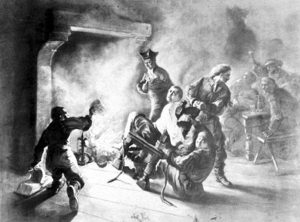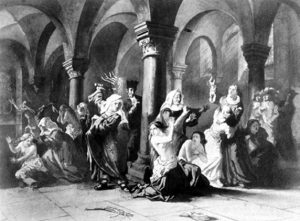Missionaries and dragoons chased the "religionnaires"
 The Dragonnades © S.H.P.F.
The Dragonnades © S.H.P.F.
About three quarters of Reformed Church members stayed in France. In the face of the “dragonnades” and all kinds of persecution that intensified between 1685 and 1700, most of these recanted.
They officially became Catholic, as stated by King Louis XIV in the introduction to the Edict of Fontainebleau (1685) : “the best and the great majority of our subjects that used to belong to the allegedly Reformed Church (“Religion Prétendue Réformée” or RPR) have become Catholics” (« la meilleure et la plus grande partie de nos sujets de la dite RPR” ont embrassé la catholique »). They were called the New Converts (N.C.).
Persecution and restriction of freedom of conscience
 Forced conversion of young girls © S.H.P.F.
Forced conversion of young girls © S.H.P.F.
The N.C. were closely monitored. They had to practice their new religion :
- be regular church-goers ;
- have Extreme Unction when near death ;
- have their children baptised by a priest and send them to catechism ;
- if they refused to perform their Catholic duties, children were taken from their parents in order that they may have a Catholic education.
Girls were sent to a convent. Often they could only get out by marrying a Catholic.
If they rebelled, they were transferred to “hospitals”, which were in fact considered as “alms houses”.
Their freedom was restricted.
More specifically was it forbidden to start law or medical school without a certificate signed by a priest proving one was a Catholic, or to sell one’s possessions without authorisation from the King.
Refusal of Extreme Unction was considered a relapse of faith. If people recovered, men might be sent to the galleys and women to prison. In case of death, the body was dragged along the public highway and your legacy confiscated.
The churches were pulled down, pastors expelled, possessions of the consistories given away to hospitals and convents.
The possessions of those who had chosen to emigrate were confiscated. Conversely, if their heirs were obedient new converts, they could have the goods and not pay any taxes on them.
Suppression of secret meetings ("Assemblies")
Anyone considered guilty of attending a secret service or a “Church of the Desert” meeting was sentenced to imprisonment or the galleys, and preachers to the gallows. Some pastors who had emigrated put their lives in jeopardy by returning to France, answering the call of the Preachers. Six pastors were arrested in Paris, sentenced to life imprisonment and jailed in Fort Sainte-Marguerite, off the coast at Cannes.
From 1686 to 1689, “conspirators” from the Cévennes, who were on their way to secret meetings, were arrested and deported to the West Indies. About one thousand left that way. Three years later, the king abandoned this measure.
The intensity of persecution varied according to Province and the Intendant in charge
In Languedoc, Intendant Basville’s repressive measures left a particularly unpleasant memory. Conversely, in Châtillon-sur-Loire, secret worship did not lead to persecution. The local priest said he was convinced that persuasion was more effective than force to bring members of the Reformed Church back to the Catholic Church. The priests had a major role as local representatives of the Intendant.
Persecution continued throughout the eighteenth century but became more sporadic. From the 1760’s, in most Provinces, tolerance was widespread.